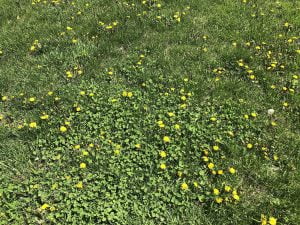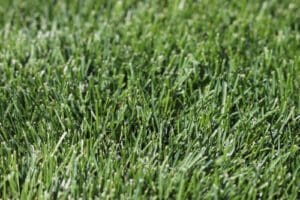A dense lawn does more than look good. It resists weeds, withstands foot traffic, and recovers faster after stress. Long-term density depends on the grass species you choose and how well it matches your site conditions. As lawn care professionals serving Milton, Canton, Randolph, and nearby towns, we often see thin lawns that struggle not because of poor maintenance, but because the wrong grass type was planted in the first place. In this article we’ll review the various types of grass seed that work for our climate and help guide you to choose the best grass type for your lawn.
Start with the Site, Not the Seed
Before selecting a grass species, the first step is evaluating the environment. Soil, sunlight, and usage patterns dictate what will thrive long-term.
- Soil texture and drainage: Clay-heavy soils retain water and compact easily, while sandy soils dry quickly. Rooting depth, oxygen exchange, and nutrient retention all depend on this foundation.
- Light exposure: Grass species respond differently to shade. Full sun, partial shade, or heavy tree cover will immediately narrow your options.
- Traffic and use: A family lawn with children and pets requires wear tolerance. A low-traffic lawn in partial shade can prioritize shade adaptation over traffic resilience.
- Microclimates: Lawns in coastal areas or on slopes face unique stresses. Identifying these early prevents failure later.
These variables matter more than seed bag labels. The most common mistake we encounter is homeowners planting a “sun and shade mix” without knowing if their soil or usage matches those claims.
Grass Species that Contribute to Density
Cool-season grasses dominate New England. Each species contributes different strengths when it comes to forming and sustaining dense turf.
Kentucky Bluegrass
Kentucky bluegrass is the benchmark for lawn density in full sun. It spreads through rhizomes, underground stems that send up new shoots. This growth habit allows bluegrass to self-repair thin spots over time. It has a fine leaf texture, excellent color, and strong recuperative potential. The drawback is slow germination — often taking 2–3 weeks — and high fertility needs. Bluegrass excels in well-drained soils with at least 6–8 hours of direct sun.
Perennial Ryegrass
Perennial ryegrass germinates quickly, usually in 5–7 days, and produces immediate ground cover. Its dense tillering creates early thickness, which is useful for overseeding. However, ryegrass is a bunch-type grass with no rhizomes, so it cannot spread laterally. It performs well in high-traffic situations because of its wear tolerance but relies on overseeding for long-term density. Ryegrass works best in blends where it provides fast cover while other species establish.
Fine Fescues
Fine fescues include creeping red, chewings, hard fescue, and sheep fescue. They are the most shade-tolerant cool-season grasses and require less nitrogen than bluegrass or rye. Their fine blades form an attractive turf in low-traffic, shaded environments. Creeping red fescue spreads through short rhizomes, but the other fine fescues are bunch-type and slower to recover from injury. For homeowners battling shade under mature trees, fine fescues are often the only sustainable option.
Turf-Type Tall Fescue
Turf-type tall fescues (TTTF) are not the coarse pasture fescues of decades past. Improved varieties now have finer blades and a darker color. Tall fescues develop deep root systems that tolerate drought and heavy traffic. They form dense clumps, and although they lack rhizomes, proper seeding rates can produce a uniform stand. TTTF is especially valuable on compacted soils or lawns with inconsistent irrigation because of its stress tolerance.
Growth Habits and Why They Matter
Understanding growth habit is critical for density. Rhizomatous grasses like Kentucky bluegrass and creeping red fescue naturally fill in gaps. Bunch-type grasses such as tall fescue and ryegrass stay where they are planted. A lawn relying only on bunch-type grasses will eventually thin without overseeding. Homeowners who want self-repairing turf should include rhizomatous species in the mix.
The Case for Blends and Mixtures
Single-species lawns offer uniform appearance but carry risk. If disease or stress targets that species, density quickly declines. Blends and mixtures balance traits across species.
In New England, the most common and effective combinations are:
- Bluegrass + Ryegrass + Fine Fescue: Bluegrass provides rhizome recovery, ryegrass gives quick germination, and fescue supports shaded areas.
- Tall Fescue Blends: Multiple tall fescue varieties sown together improve genetic diversity and increase tolerance to stress.
Blends allow one species to compensate when another is under pressure, sustaining density over the long term.
Timing and Seeding Practices
Establishing a dense lawn is not just about seed choice but also timing. In our area, the best window is early fall — late August through September. Soils are still warm for germination, daytime highs are moderate, and weed competition is reduced compared to spring.
Correct seeding rates are just as important. For example:
- Kentucky bluegrass: 1–3 lbs per 1000 sq ft
- Perennial ryegrass: 5–9 lbs per 1000 sq ft
- Tall fescue: 6–8 lbs per 1000 sq ft
Starter fertilizer ensures seedlings access phosphorus for root development. Rolling or light raking improves seed-to-soil contact, which is critical for uniform density.
Practices that Sustain Density
Once established, management dictates whether the lawn stays thick.
- Mowing: Keep bluegrass and ryegrass at 2.5–3.5 inches, and tall fescue at 3–4 inches. Cutting too short reduces photosynthesis and weakens turf.
- Fertilization: Match nitrogen inputs to the species. Bluegrass and ryegrass require more frequent feeding, while fine fescues thrive with less. Soil tests guide exact programs.
- Irrigation: Deep, infrequent watering encourages deeper rooting. Constant shallow watering promotes shallow roots and disease.
- Aeration and Overseeding: Annual core aeration relieves compaction and provides a seedbed for overseeding. Overseeding keeps bunch-type grasses thick and counters natural thinning.
Problems and How Grass Choice Solves Them
- Shade thinning: Fine fescues sustain density where bluegrass fails.
- Traffic wear: Tall fescue and ryegrass outperform fescues and bluegrass in heavy-use areas.
- Poor drainage: Tall fescue tolerates wet conditions better than bluegrass, but drainage correction may be needed for lasting density.
Local Considerations for Milton, Canton, and Braintree
Lawns in our service area often sit on compacted subsoil left after construction. This favors tall fescue because of its deep rooting and tolerance for poor drainage. Established neighborhoods with sandy loam soils can support bluegrass-based mixes, especially in sunny yards. For shaded streets with mature oaks and maples, fine fescues dominate. We frequently recommend custom blends that match the exact conditions rather than generic seed mixes from hardware stores.
When to Call a Professional
Homeowners can overseed small areas themselves, but entire-lawn renovations, persistent compaction, or recurring turf diseases benefit from professional attention. Our process includes soil testing, custom seed recommendations, precise seeding rates, and follow-up fertilization. This approach eliminates guesswork and ensures density holds season after season.
Why Work With Molloy Lawn & Landscape
We’ve been helping Milton-area homeowners build dense lawns since 1963. Our team matches grass species to soil and site conditions rather than taking a one-size-fits-all approach. Services include:
- Soil testing and site evaluation
- Overseeding with custom grass blends
- Core aeration and topdressing for compaction relief
- Seasonal fertilization tailored to chosen species
- Drainage improvements for waterlogged soils
We stand behind every project with a 100% satisfaction guarantee. If you want a lawn that stays thick and resilient, we provide the seed, the science, and the ongoing care to make it happen.
FAQs
Which grass makes the thickest lawn in New England?
Kentucky bluegrass produces the densest turf in sun, but mixes with ryegrass and fescue maintain thickness across a wider range of conditions.
Can I mix tall fescue with bluegrass?
Yes. Tall fescue adds stress tolerance while bluegrass fills gaps with rhizomes. This combination works well in many local yards.
When is the best time to seed for density?
Early fall is best in Massachusetts. Warm soil speeds germination while cooler nights reduce stress on seedlings.
How much seed should I use for overseeding?
Rates vary by species. Bluegrass requires only 1–3 lbs per 1000 sq ft, while tall fescue often needs 6–8 lbs.
Will my lawn thicken without overseeding?
Only rhizomatous grasses like Kentucky bluegrass spread naturally. Bunch-type species thin out over time unless overseeded.



